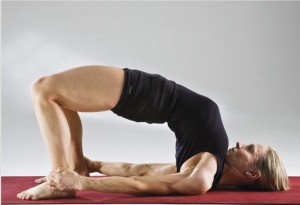What’s the best time of day to do shoulder stand?
The pat answer is that disciplined yogis always do their practice first thing in the morning, so the best time is toward the end of morning practice.
The practical answer is: whenever you can.
Perhaps you have to leave for work too early to make morning practice anything but a pre-dawn penance. Or maybe you’re a night owl, and the idea of early practice is as appealing as a hearty breakfast of oatmeal porridge.
Lately I’ve been reminded of just how well shoulder stand fits into the end of the day.
Here on day 52 of my 90 days of shoulder stand, I’ve noticed a pattern: Tuesdays, Wednesdays, Thursdays and Saturdays are early morning practice days. Sundays, Mondays and Fridays, I practice late in the afternoon.
By 4 p.m., I’m usually sliding into my lowest ebb of energy for the day, the fuzzy-headed, caffeine-craving black hole of afternoon slump.
So I start my practice lying down on the floor, preferably cross-legged, with a wood brick on its flat side under my shoulders and my head.
Then depending on the time I have left, I practice, with shoulder stand close to the end.
Yes, I work hard in the pose, particularly through my legs, shoulders and upper arms.
But when I come down, I feel soothed, calm and energized – exactly the mood that goes best with cooking dinner.
It’s like getting an extra four hours of useful time in the day.
I know that late-afternoon shoulder stands aren’t accessible to everyone – especially if you have a family that needs to eat early.
But supposing you can work it in, here’s a half-hour routine to take you from the end of the day slump to renewed energy for the evening.
1. Start with your favorite chest opening. Spend five minutes relaxing your face and your eyes, and letting yourself become present in your body.
2. Stretch your side body in child’s pose, then take that length into dog pose. Hold dog pose, working your thighbones up and back, for between one and five minutes.
3. Sit in hero pose and stretch your shoulders in Gomukhasana (or better yet the full pose, complete with Gomukhasana arms, if it’s suitable for you. See plates 80 and 81 in Light on Yoga)
4. Set up for your shoulder stand, and lie down on the blankets. Take your strap around your ankles, holding one end in each hand, stretch your tailbone toward your heels, then lift your buttocks to come up into Chattush Padasana (four-foot pose).

This is Chattush Padasana without support. For a more accessible version, do it from your shoulder stand setup with a strap around your ankles.
Come on to the outside edges of your shoulders, and lift your buttocks higher. Curl your tailbone toward your spine as you come down. Repeat.
You’ll find that having the shoulder stand setup under your shoulders helps you open your chest in this back bend.
(James Murphy, at the Iyengar Yoga Institute of New York has an excellent sequence of practices available as a free pdf, That’s where I found this picture of Chattush Padasana without support.)
5. Swing your legs over into plow pose. Stay for a minute or longer, then go into shoulder stand. Stay for five minutes or longer, including the variations you’re working with.
Lower your legs back into plow pose, remove your strap and roll out. Keep your buttocks on your shoulder stand platform, and bring your shoulder blades onto the floor.
6. Do relaxation pose for five minutes. Then rise renewed – feeling much better than you would have if you’d eaten those little cakes.
Photo courtesy of Magnus D, via Flickr.
If you liked this post you might also like:
90 days of shoulder stand: a long and winding road
Morning yoga practice: if it’s so important, why is it so hard to do?
Where do you find your inner teacher?





Comments on this entry are closed.
Thank you . The iPad does not go to the link but I googled the site you suggested and it works.
I’m glad it worked, Loretta.
Hi Eve,
I would like to see the sequence that you refer to in this posting (James Murphy). I am unable open it. Could you please forward the link. Thank you for all your suggestions. Loretta
Hi Loretta,
I’m not sure what the problem is. I tried the link and it worked fine – the pdf downloaded for me. How about googling James Murphy chattush padasana? When I did that, I also found the pdf that has the sequence in it.
I hope that works.